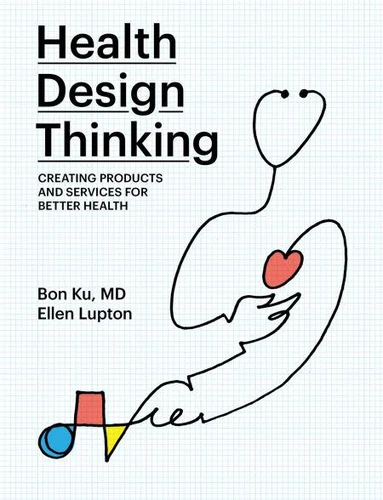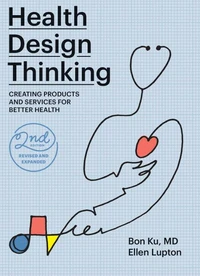Health Design Thinking. Creating Products and Services for Better Health
Par : ,Formats :
Disponible dans votre compte client Decitre ou Furet du Nord dès validation de votre commande. Le format Epub fixed layout protégé est :
- Compatible avec une lecture sur My Vivlio (smartphone, tablette, ordinateur)
- Compatible avec une lecture sur liseuses Vivlio
- Pour les liseuses autres que Vivlio, vous devez utiliser le logiciel Adobe Digital Edition. Non compatible avec la lecture sur les liseuses Kindle, Remarkable et Sony
- Non compatible avec un achat hors France métropolitaine
 , qui est-ce ?
, qui est-ce ?Notre partenaire de plateforme de lecture numérique où vous retrouverez l'ensemble de vos ebooks gratuitement
Pour en savoir plus sur nos ebooks, consultez notre aide en ligne ici
- Nombre de pages228
- FormatEpub fixed layout
- ISBN978-0-262-35891-0
- EAN9780262358910
- Date de parution17/03/2020
- Protection num.Adobe DRM
- Taille45 Mo
- Infos supplémentairesepub
- ÉditeurThe MIT Press
Résumé
Applying the principles of human-centered design to real-world health care challenges, from drug packaging to early detection of breast cancer. This book makes a case for applying the principles of design thinking to real-world health care challenges. As health care systems around the globe struggle to expand access, improve outcomes, and control costs, Health Design Thinking offers a human-centered approach for designing health care products and services, with examples and case studies that range from drug packaging and exam rooms to internet-connected devices for early detection of breast cancer.
Written by leaders in the field-Bon Ku, a physician and founder of the innovative Health Design Lab at Sidney Kimmel Medical College, and Ellen Lupton, an award-winning graphic designer and curator at Cooper Hewitt Smithsonian Design Museum-the book outlines the fundamentals of design thinking and highlights important products, prototypes, and research in health design. Health design thinking uses play and experimentation rather than a rigid methodology.
It draws on interviews, observations, diagrams, storytelling, physical models, and role playing; design teams focus not on technology but on problems faced by patients and clinicians. The book's diverse case studies show health design thinking in action. These include the development of PillPack, which frames prescription drug delivery in terms of user experience design; a credit card-size device that allows patients to generate their own electrocardiograms; and improved emergency room signage.
Drawings, photographs, storyboards, and other visualizations accompany the case studies. Copublished with Cooper Hewitt, Smithsonian Design Museum
Written by leaders in the field-Bon Ku, a physician and founder of the innovative Health Design Lab at Sidney Kimmel Medical College, and Ellen Lupton, an award-winning graphic designer and curator at Cooper Hewitt Smithsonian Design Museum-the book outlines the fundamentals of design thinking and highlights important products, prototypes, and research in health design. Health design thinking uses play and experimentation rather than a rigid methodology.
It draws on interviews, observations, diagrams, storytelling, physical models, and role playing; design teams focus not on technology but on problems faced by patients and clinicians. The book's diverse case studies show health design thinking in action. These include the development of PillPack, which frames prescription drug delivery in terms of user experience design; a credit card-size device that allows patients to generate their own electrocardiograms; and improved emergency room signage.
Drawings, photographs, storyboards, and other visualizations accompany the case studies. Copublished with Cooper Hewitt, Smithsonian Design Museum
Applying the principles of human-centered design to real-world health care challenges, from drug packaging to early detection of breast cancer. This book makes a case for applying the principles of design thinking to real-world health care challenges. As health care systems around the globe struggle to expand access, improve outcomes, and control costs, Health Design Thinking offers a human-centered approach for designing health care products and services, with examples and case studies that range from drug packaging and exam rooms to internet-connected devices for early detection of breast cancer.
Written by leaders in the field-Bon Ku, a physician and founder of the innovative Health Design Lab at Sidney Kimmel Medical College, and Ellen Lupton, an award-winning graphic designer and curator at Cooper Hewitt Smithsonian Design Museum-the book outlines the fundamentals of design thinking and highlights important products, prototypes, and research in health design. Health design thinking uses play and experimentation rather than a rigid methodology.
It draws on interviews, observations, diagrams, storytelling, physical models, and role playing; design teams focus not on technology but on problems faced by patients and clinicians. The book's diverse case studies show health design thinking in action. These include the development of PillPack, which frames prescription drug delivery in terms of user experience design; a credit card-size device that allows patients to generate their own electrocardiograms; and improved emergency room signage.
Drawings, photographs, storyboards, and other visualizations accompany the case studies. Copublished with Cooper Hewitt, Smithsonian Design Museum
Written by leaders in the field-Bon Ku, a physician and founder of the innovative Health Design Lab at Sidney Kimmel Medical College, and Ellen Lupton, an award-winning graphic designer and curator at Cooper Hewitt Smithsonian Design Museum-the book outlines the fundamentals of design thinking and highlights important products, prototypes, and research in health design. Health design thinking uses play and experimentation rather than a rigid methodology.
It draws on interviews, observations, diagrams, storytelling, physical models, and role playing; design teams focus not on technology but on problems faced by patients and clinicians. The book's diverse case studies show health design thinking in action. These include the development of PillPack, which frames prescription drug delivery in terms of user experience design; a credit card-size device that allows patients to generate their own electrocardiograms; and improved emergency room signage.
Drawings, photographs, storyboards, and other visualizations accompany the case studies. Copublished with Cooper Hewitt, Smithsonian Design Museum




